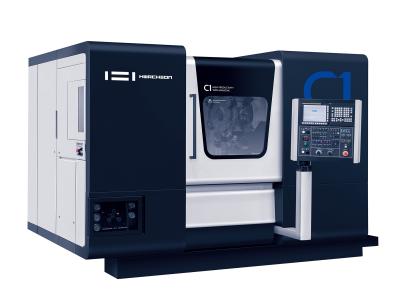
Hwacheon Machinery America Inc. introduces the C1 multiple-process turning center. Half turning center, half machining center (Y- and C-axis control), the C1 can completely manufacture parts with complicated shapes in a single chucking operation.
The C1 processes not only with ease, but also with maximum efficiency, according to the company. Engineered with a triple-stack turret with a toolchanger, the C1 holds up to 36 tools and increases productivity. A multitude of tools allows for the precise machining of complex parts with drastically reduced setups, enables multiple jobs to be tooled up and is ideal for short run jobs.
The C1 is also engineered for accuracy. Designed to minimize thermal displacement, the arrangement of units in the heat-symmetrical structure provides superior thermal stability. Hwacheon’s original cooling system ensures that the rotary tool module inside the turret maintains exceptional processing quality, even during prolonged operation. In addition, the C1’s independent orthogonal structure of X, Y and Z axes reduces feed error to zero for high rigidity and precision, even during prolonged processing.
The C1 swing over bed diameter is 28.74”, maximum cutting diameter 20.88”, maximum cutting length 23.58” and maximum spindle speed is 6,000 rpm. A range of C1 options are available, including an automatic tool presetter and a second spindle.
Contact Details
Related Glossary Terms
- feed
feed
Rate of change of position of the tool as a whole, relative to the workpiece while cutting.
- machining center
machining center
CNC machine tool capable of drilling, reaming, tapping, milling and boring. Normally comes with an automatic toolchanger. See automatic toolchanger.
- toolchanger
toolchanger
Carriage or drum attached to a machining center that holds tools until needed; when a tool is needed, the toolchanger inserts the tool into the machine spindle. See automatic toolchanger.
- turning
turning
Workpiece is held in a chuck, mounted on a face plate or secured between centers and rotated while a cutting tool, normally a single-point tool, is fed into it along its periphery or across its end or face. Takes the form of straight turning (cutting along the periphery of the workpiece); taper turning (creating a taper); step turning (turning different-size diameters on the same work); chamfering (beveling an edge or shoulder); facing (cutting on an end); turning threads (usually external but can be internal); roughing (high-volume metal removal); and finishing (final light cuts). Performed on lathes, turning centers, chucking machines, automatic screw machines and similar machines.






